Node.js Statistics By Learning, Developer And Facts (2025)
Updated · Sep 03, 2025
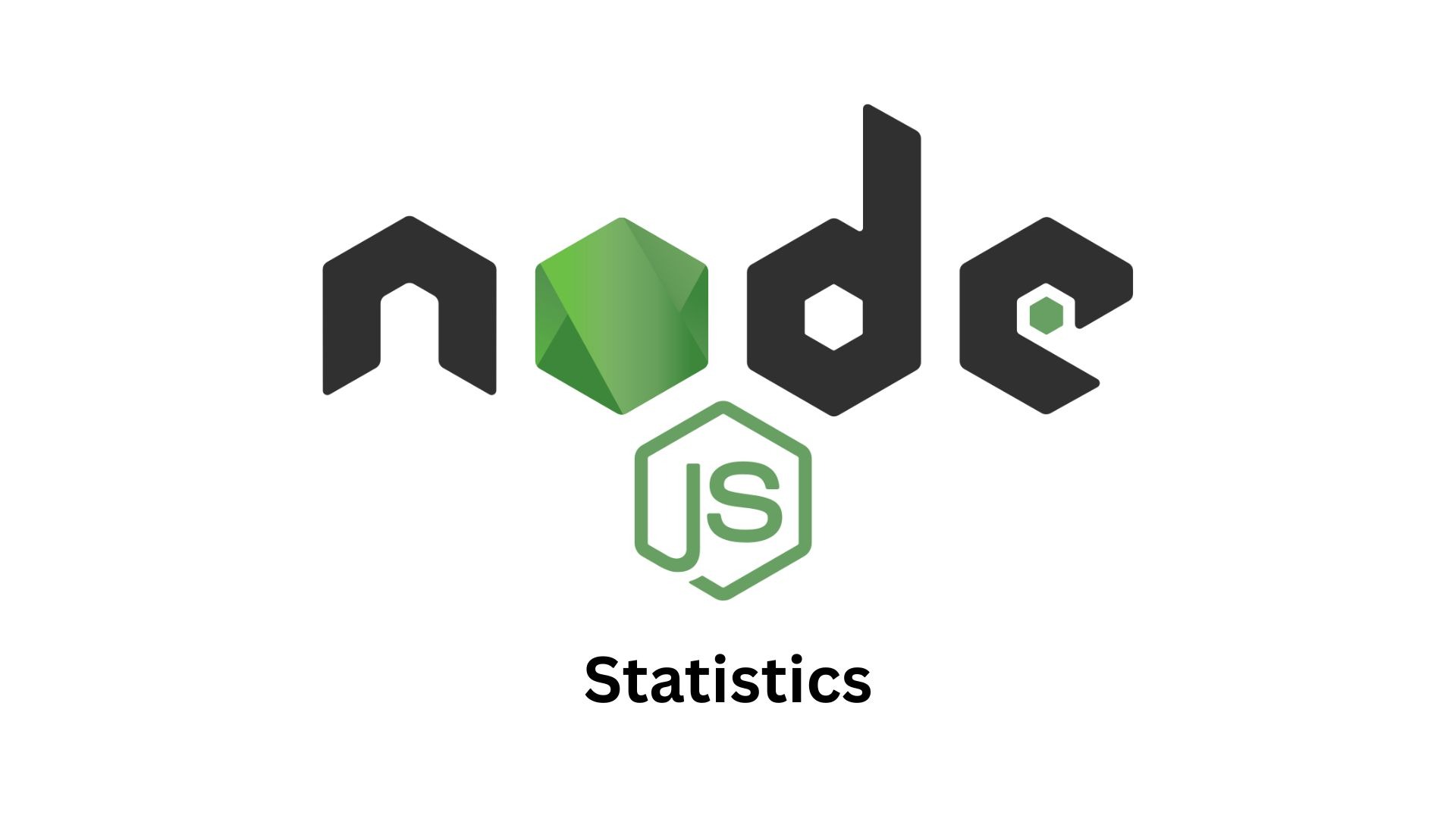
Table of Contents
- Introduction
- Editor’s Choice
- Most Used Web Frameworks Among Developers Worldwide
- Node.js Release Cycle
- Node.js Used In Industry Verticals
- Node.js By Products And Services
- Node.js Customers By Employee Size
- Node.js Geographical Presence
- Node.js Statistics On Why Businesses Use Node.js Over Other Technologies
- Node.js Developer Statistics
- Node.js Developer By Regions
- Node.js Statistics By Learning
- Conclusion
Introduction
Node.js Statistics: Node.js has become one of the most widely used backend technologies worldwide. Lightweight, highly scalable, and suitable for real-time applications, Node.js continues to see widespread adoption by developers, as well as large enterprises, in 2024. Top-tier companies, such as Netflix, PayPal, Uber, LinkedIn, Walmart, and eBay-Nodes, use the technology for performance and efficiency.
Here are some details about Node.js statistics for 2024 with market share, developer use, performance, job salary, and business impact.
Editor’s Choice
- Node.js has mainly overgrown React.js in terms of developer usage in 2024, according to estimates of 40.8% globally.
- More than 6.3 million websites are presently using Node.js for development worldwide.
- The use of Node.js helped companies reduce costs by development costs by up to 58%.
- Node.js leads Electronics & Technology (6.1%), Law & Government (3%), Arts (2.55%), and Finance (2.5%).
- About 116 thousand Node.js using companies have less than 10 employees, indicating widespread adoption among startups and smaller businesses.
- 38.5% of Node.js’s usage comes from Software Development, while 33.1% comes from Web Development.
- According to the IDC study, Node.js increases developer productivity by 68%.
- 52% of professional developers chose Node.js as their tech stack in 2023 for their web app development.
- 42.44% of new programmers prefer to learn Node.js along their road of career development path.
- With 12 million programmers worldwide, Node.js speaks 45 different languages across 85 countries.
- Senior engineers trust Node.js, with 60% of its developers having over 5 years of experience.
- In the evaluation of respondents, 4% stated that to had witnessed no change after switching to Node.js, signifying that this is a highly successful choice.
- More than 55% of the users pick Long-Term Support (LTS) versions of Node.js.
- All Node.js versions aggregate to 40% year-over-year growth in downloads.
- While Node.js is most prevalent in the US and Canada, which houses 32% of its developers, 51% of Node.js developers learned their language, giving it a heavy global accessibility.
- 40% of Node.js developers don’t mind teaching others; that’s a strong and supportive community.
Most Used Web Frameworks Among Developers Worldwide
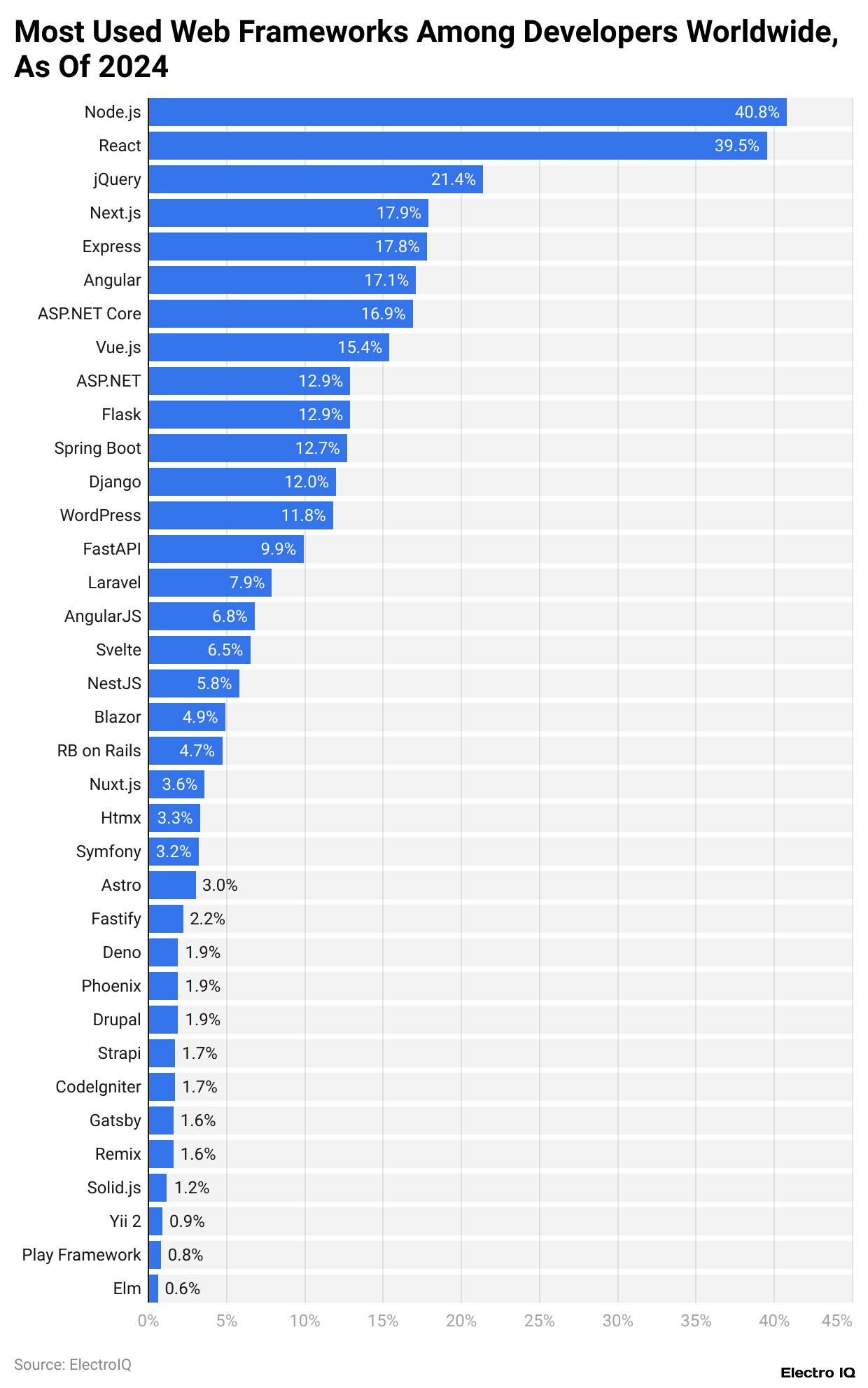
(Reference: statista.com)
- The year 2024 saw Node.js surpass React.js in popularity among developers worldwide.
- There was a survey report stating that 40.8% of the developers use Node.js, followed by 39.5% who use React.js.
- A framework in web design is software that helps developers create web projects easily.
- It takes care of mundane tasks encountered in web development, thus the developer gains much time and energy. These tools help simplify the development of websites.
- Before the rise of React.js, jQuery used to be the most widely used framework by developers. jQuery is a JavaScript library that facilitates the writing of JavaScript code for websites.
- Although jQuery is not very popular nowadays, JavaScript, as a language, still stands as the most popular language among developers worldwide.
- Different programming languages come with different levels of income.
- JavaScript developers get an average salary of US$65,580 worldwide; however, in the U.S., JavaScript developers often earn quite a bit more, with an average salary of around US$112,000.
Node.js Release Cycle
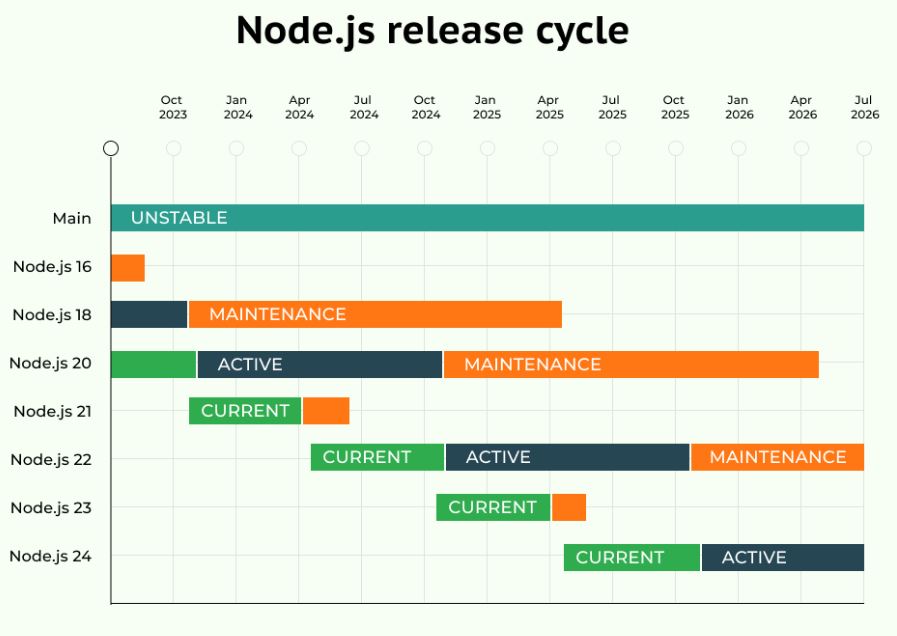
(Source: agileinfoways.com)
- As per Agileinfoways, Node.js statistics show that Node.js undergoes continued improvements: with every major release, further features and bug fixes are added.
- One of the most recent releases includes Node.js 22 (version 22.0.0 together with npm 10.5.1).
- This version packs some significant updates: the WebSocket client is enabled by default, watch mode is stable now, and there is pattern matching support has been added to the file system module (fs).
- With this release comes another new flag called –run, which allows developers to execute scripts much quicker than with npm run for scripts listed in package.json.
- These enhancements have drawn considerable attention from developers due to their ability to expedite the software development process and increase convenience.
- Node.js 22 is anticipated to become an official LTS release by October 2024.
- Therefore, developers and companies should start thinking about upgrading and installing the latest versions of Node.js and npm to stay current and reap these benefits.
Node.js Used In Industry Verticals

(Reference: bigohtech.com)
- As per Biotech, Node.js statistics state that the most used Node.js industry very well reveals the huge flexibility and power of Node.js.
- Electronics, Computers, and Technology take the biggest share of usage, constituting 6.1% of all Node.js applications. But one cannot simply constrict him or herself to technology.
- Node.js, in fact, is used by the Law and Government sectors at 3%, the Arts and Entertainment sectors at 2.55%, and the Finance sector at 2.5%.
- This suggests that many and varied fields are embracing Node.js because it performs well for a wide array of needs and services.
Node.js By Products And Services
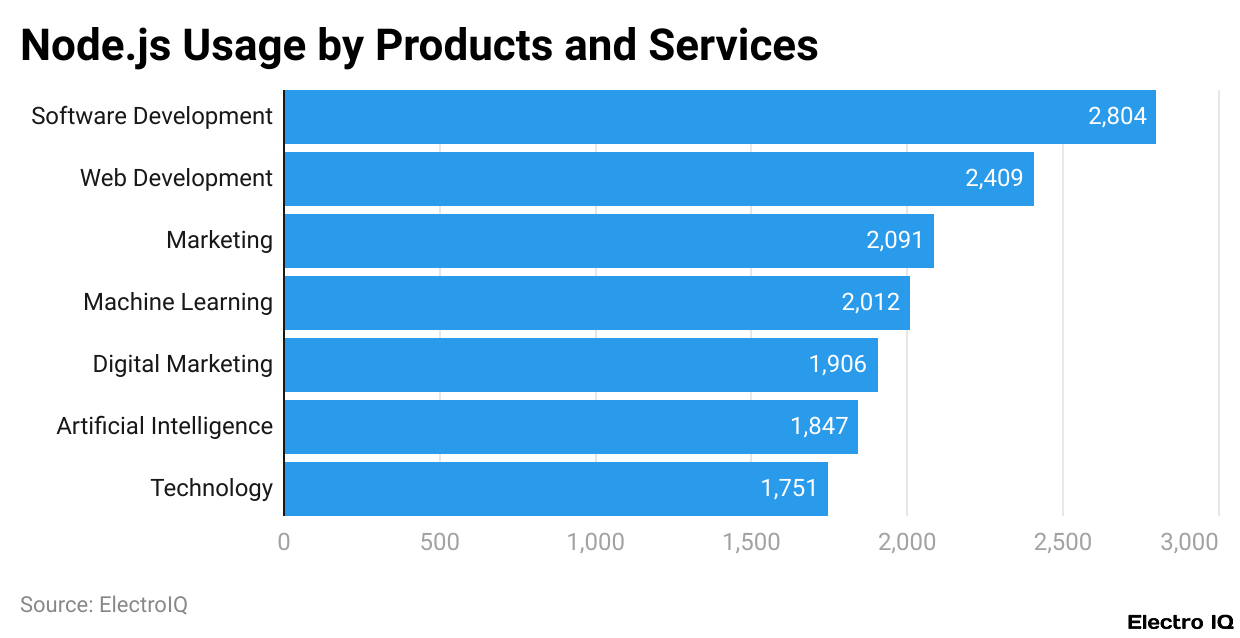
(Reference: brilworks.com)
- Node.js usage in the Software Development domain is almost 38.5%.
- The next most used domain is Web Development, with 33.1%.
- Marketing teams follow up very closely, constituting about 28.7% of Node.js users.
- This indicates that Node.js finds immense use in domains that are very technology-dependent and that have pressing needs for quick and scalable solutions.
Node.js Customers By Employee Size
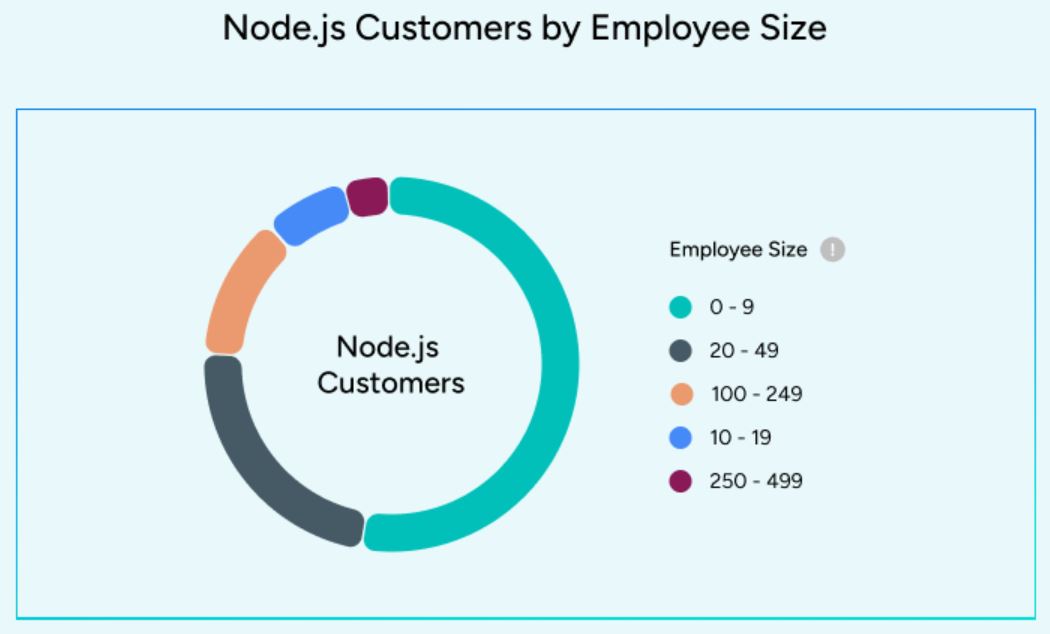
(Source: brilworks.com)
- Node.js is mostly small-scale companies that implement Node.js, not very large ones.
- About 116,000 businesses use Node.js and have from 0 to 9 employees; this means many are really small or early-stage businesses.
- 51,560 companies use Node between 20 and 49 employees; while mid-sized companies in the range of 100- and 249 employees number about 26,246.
- Hence, it is evident that Node.js is highly regarded by startups and mid-sized companies due to its lightweight nature, speed, and compatibility with scarce resources.
Node.js Geographical Presence
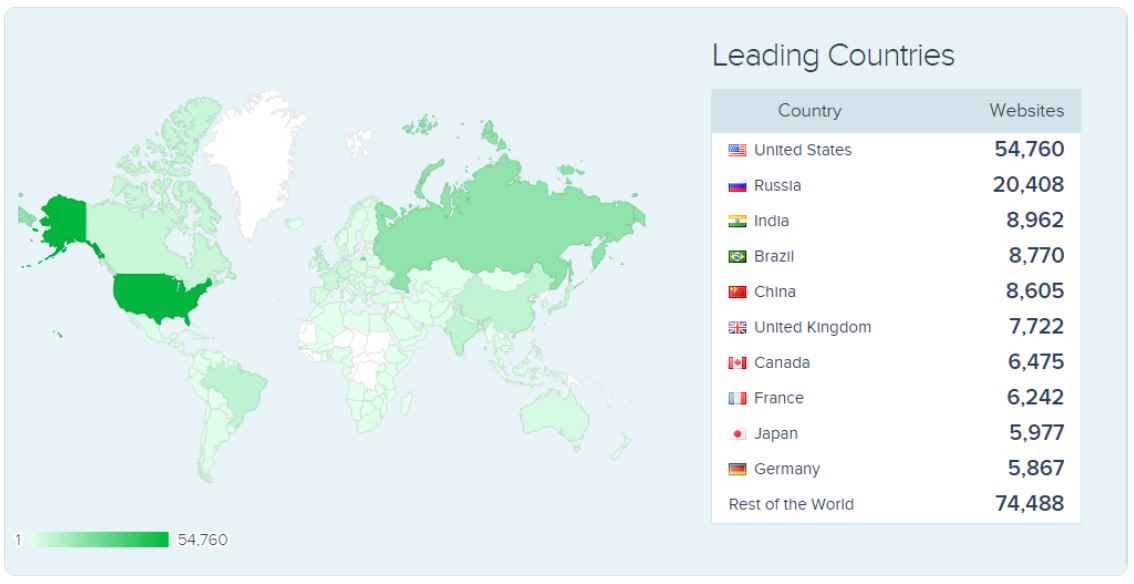
(Source: esparkinfo.com)
- Approximately 6.3 million websites have been made using Node.js, which remains one of the most commonly used tools in web development today.
- These figures show how deeply Node.js has embedded itself within the world of website and web application creation.
- It said that Node.js is more popular in the US, though it also has a huge presence globally across different countries and various regions.
- The Node.js technology has transitioned to almost every continent in the world.
- Not only geographically popular, but also highly industry popular; this depicts its growth and worldwide impact that is across many industries, hence affirming its breadth and domination.
Node.js Statistics On Why Businesses Use Node.js Over Other Technologies
- There are plenty of good reasons why Node.js is preferred by businesses over other technologies.
- One of the biggest reasons was the rather huge active developer community for Node.js.
- Hiring Node.js developers is also easier than hiring developers for some other frameworks, thereby saving companies’ time and money. Some companies that decided to switch have reported huge savings.
- Development cost can be cut by nearly 58% because the same programming language, JavaScript, gets used on the frontend as well as on the backend; therefore, fewer developers are needed to make it through with a project.
- Moreover, it was observed that businesses gained long-term savings, as statistics show that, after working for two years with Node.js, organisations saved about 12% in development costs.
- This, therefore, proves that Node.js is not only fast and effective but also cost-efficient.
- In addition, Node.js is mostly successful for those companies that are implementing it.
- Merchants who said they neither achieved nor felt any outcome after the move represent little else but 4%, meaning most companies saw enhancements.
- One of the greatest technical perks of Node.js is rapid loading speed.
- A page load time may be reduced by 50-60%, which is great, enabling either single-page applications or heavy applications that handle data in real time.
- Real-world examples are LinkedIn, which reduced its page load time by 20% upon migrating to Node.js. Netflix’s page load time went up with an improvement of 60%.
- PayPal’s code ran 35% faster, whereby pages currently loaded 200 milliseconds faster than when in Java.
- Walmart, with an estimated 80 million visits per month, also uses Node.js for performance, SEO, and checkout conversion hogging. This shows it caters for Node.js in supporting any big businesses under high traffic.
- Node.js is generally used in e-commerce websites, crowdfunding, IoT applications, and payment-related activities.
- Large companies record their usage of Node.js in creating modern high-speed applications; this includes Amazon, Netflix, Reddit, LinkedIn, PayPal, and eBay.
- eBay and AliExpress are two largest online markets in the world that are heavily dependent on Node.js for performance and reliability.
- Another benefit of Node.js is efficiency: companies can run applications on fewer servers. This also means that fewer people will be needed for administration and maintenance, thereby minimizing the deployment cost and maintenance costs.
Node.js Developer Statistics
- According to IDC, Node.js statistics reveal that Node.js can increase developer productivity by up to 68%.
- This is especially so since the developers do not have to switch between different languages or tools-they just use the same language-JavaScript-for both frontend and backend development.
- This makes the code easier to maintain and faster to build.
- Approximately 46% of Node.js developers range from 25 to 35 years in age. This indicates a strong future for the technology since its adoption has been more or less forced upon young programmers in their initial stages.
- Besides, about 36.42% of these developers are active users of Node.js libraries, frameworks, and IDEs, exhibiting how active and modern the community is.
- Node.js is an internationally recognized product supported in about 85 countries, with developers hailing from at least 45 language backgrounds.
- About 46% of Node.js developers speak English, whereas around 6% speak German or Spanish.
- The language is most popular in English-speaking countries but is spread throughout different regions and languages worldwide.
Node.js Developer By Regions
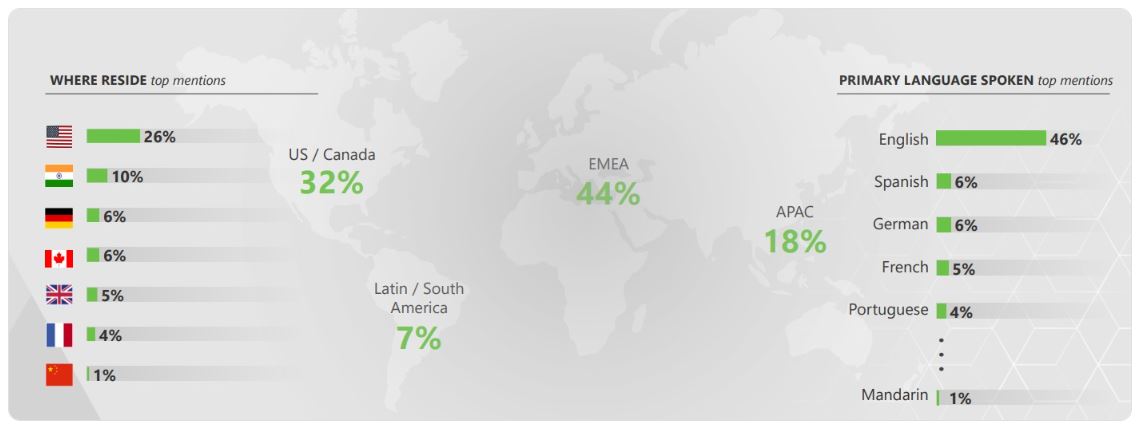
(Source: esparkinfo.com)
- About 32% of all Node.js developers are based in the United States and Canada, suggesting that much of the Node.js talent originates from regions with good salary standards.
- Another 44% could be found in the EMEA area (Europe, the Middle East, and Africa).
- This implies that most Node.js developers are based in countries with robust economies and potentially better wage scales.
- In the North American region, around 91% of Node.js developers are males, which clearly states a gender gap if we consider the fact that women constitute approximately 25% of the global programming population.
- Node.js is famous with small companies and startups having the flexibility, speed, and cost-effectiveness that it provides; about 60% of Node.js developers work for firms with under 100 employees.
- An equal number of those have five or more years of experience, which suggests that many developers resort to using Node.js as they grow more advanced in their careers; an indication of confidence and maturity in this technology.
- Most of the Node.js developers find themselves in back-end-based or full-stack jobs; three out of every four Node.js programmers make use of it for server-side or full-stack development, whereas just one in four use it predominantly for front-end development.
- This goes ahead to prove that Node.js is more sturdy on the server-side and that it’s more in favor of experienced developers who develop end-to-end applications.
Node.js Statistics By Learning

(Reference: esparkinfo.com)
- About 42.44% of the new coders set their sights on learning Node.js, considering a boost to their career, which ranks high amongst the others in the list, including older ones.
- Around 52% of developers with working and experienced backgrounds grow uneasy whenever using Node.js for web application building in 2023.
- Curiously, 51% of developers of Node.js hold college diplomas, while a fraction of 21% are complete college graduates.
- Thus, it would seem that this technology necessitates a certain cognitive understanding and ER formal learning.
- Learning in one’s mother tongue usually affords convenience, and that 51% of Node.js developers indicated they learned Node.js in their mother tongue speaks slightly to the abundance of local learning resources.
- The programming world has always cherished community support and knowledge sharing, and about 40% of Node.js developers said they would be willing to teach Node.js to a beginner.
- Such zeal and mentorship will only enable his technology to gain more among fresh learners.
Conclusion
Node.js Statistics: Node.js in 2024 remains aimed at enabling not small startups but Netflix, Uber, and Walmart to Geh under the umbrella of companies. It is known for high-speed performance, cost efficiency, and fast development cycles, plus an enormous support group backing it. The demand came mainly from real-time features, scalability, and a single JavaScript stack. Businesses running Node.js get faster page load times, cheaper server costs, and more efficient company developers. As more and more companies trend into microservices and real-time applications during and after 2024, Node.js will gain substantial momentum. Hence, I can say that the future for Node.js looks very promising, both for market value and for developer preferences.
FAQ.
In 2024, 40.8% of global developers preferred to use Node.js over React. The main reason being that Node.js is a full backend runtime environment that supports server-side development and allows page speed and scalability.
The cost of development can be reduced by 58% while using Node.js as it allows using the same language, JavaScript, on both sides of a client and server, thereby, reducing the number of developers required and making the project easy to manage.
Though Node.js has wide usage across technology-driven fields like Electronics and IT (6.1%), it is also prevalent in Law & Government, Arts & Entertainment, and Finance. The platform enjoys majority support among startups and small companies, with around 116,000 Node.js-using companies having fewer than 10 employees.
Node.js is used heavily by full-stack and backend developers; about 75% of Node.js programmers employ the technology in backend or full-stack positions. Also, about 60% of these developers have more than 5 years of experience with it, implying that even senior developers put their trust in it; a large portion of the users comprises young developers between 25 and 35 years old, with nearly 42.44% of those entering the profession opting for Node.js as their first backend technology for its career potential.
If Node.js is used in at least 85 countries and among those based in over 45 different native languages, it shows that Node.js has reached a worldwide status. Around 32% of Node.js developers are found in the United States and Canada, while 44% of those in the EMEA region. Further support is given by developers, too-they say that about 40% of Node.js developers tend to teach others.

I hold an MBA in Finance and Marketing, bringing a unique blend of business acumen and creative communication skills. With experience as a content in crafting statistical and research-backed content across multiple domains, including education, technology, product reviews, and company website analytics, I specialize in producing engaging, informative, and SEO-optimized content tailored to diverse audiences. My work bridges technical accuracy with compelling storytelling, helping brands educate, inform, and connect with their target markets.










